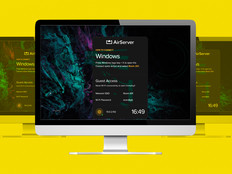Simple Steps to Achieve a Paperless Office
Consider a typical meeting scenario: An administrator prints out 15 copies of a multipage presentation to distribute to attendees, who glance at the material for a few minutes and leave it on the table when the meeting adjourns.
That's exactly the type of waste that Brian "Buzz" Kehoe seeks to avoid. Kehoe, IT director for the city of Rifle, Colo., is working hard to rein in the senseless use of paper throughout city government. "It's about saving money and efficiency. Paper is one communication system, but there are many others, such as phone, email, social media and text," he says.
So far, Rifle has achieved better management of printers and copiers, and drastically reduced the use of fax machines in favor of electronic communications. One major initiative swapped the paper agendas for endless government meetings with digital LED displays.
A Proper Display
Kehoe outfitted six of the city's conference rooms with an array of 32- to 70-inch wall-mounted flat-panel displays from LG Electronics, Sharp Electronics, Sony and ViewSonic. Presenters control the displays with a PC, wireless keyboard and mouse, and teams can edit electronic documents on the fly. Visitors can also use the system through guest login, with their documents stored on a USB drive.
"I didn't want to implement a $50,000 solution to solve a simple problem," Kehoe explains. "And it's simple, so our small IT staff isn't overburdened with supporting yet another complex technology."
Projects such as the city of Rifle's demonstrate important progress in going paperless, says Doug Miles, director of market intelligence for AIIM, a market research company.
"We consider the paper-free office to be an aspirational goal, but creating paper-free processes is absolutely achievable and highly beneficial," Miles says. He points to scanning and document capture, implementing an electronic-only filing policy and digital signature as some of the most useful steps organizations can take.
Order in the Court
In Pinellas County, Fla., every piece of information for every petition or court case is filed with the Clerk of the Circuit Court. Faced with drastic budget cuts and the need to lay off personnel, the office got serious about reducing the use of paper and the processes required to handle it.
15%
The average percentage of office space taken up by paper — a figure that could drop as low as 7% over five years with an all-electronic filing policy
SOURCE: "The Paper Free Office: Dream or Reality?" (AIIM, 2012)
"Although we had been using imaging to some extent for a while, this was the catalyst for finding ways to be even more efficient and make big changes," says Ken Burke, Pinellas County clerk of the circuit court and comptroller.
The first step was increasing the use of imaging by adding workflow through a combination of Fujitsu scanners and OpenText Case360 adaptive case management software. This initiative began with the paper workflow between the Clerk's Office and the Judiciary because it was one of the most paper-intensive operations.
"Every piece of paper has a process to it, and a lot of people have to touch it as part of the process, both in our office in downtown Clearwater and our other courthouse in St. Petersburg, 20 miles away," Burke explains. "Before we did this, we actually had to ship files back and forth."
In addition to using only electronic files, Burke's team had to make sure the workflow safeguarded confidential documents. In addition, they had to develop a Java applet for Case360 to allow judges to access a TIFF file of their signatures and apply them to the electronic documents.
By mandate, as of April 1, attorneys must file motions in electronic format through the Florida Courts eFiling Portal. That will make Pinellas County's job easier, but there will always be paper to deal with, especially from citizens who aren't represented by attorneys. In that case, Burke says, the paper will be imaged immediately, and the originals boxed and stored. From that point on, everything related to the case will be in digital format.
Since the imaging solution was deployed, the Clerk of the Circuit Court has reduced its workforce by about 40 percent, mainly from eliminating jobs related to managing paper processes, says Diane Elliott, probate court records manager.
Writ Large
The city of Claremont, Calif., freshened up its facilities by swapping in digital signage to replace bulletin boards that had to be manually changed whenever information changed.
"We started with an information board in front of city hall to show the dates and times of meetings, and it worked so well that we decided to expand their use," says Ron Gray, IT technician for Claremont.
Today, the expanded deployment includes four digital signs placed in city hall, a community center and senior centers. The solution includes ViewSonic 42-inch flat-panel displays, ViewSonic VOT132 Windows 7 mini PCs and Best Wave DisplayIt digital signage software.
"There's a lot more we could do," says Gray, such as replacing conference room nameplates that need to be changed for each meeting with small digital signs that can be centrally managed.
Keep Out
The best way to keep paper out of the office is to head it off at the door, says Doug Miles, director of market intelligence for AIIM. For example, implementing a digital mailroom enables the majority of government mail to be scanned as it arrives and electronically delivered to recipients.
"This process allows inbound mail reception to be centralized, adding economies of scale, and lending itself to outsourcing," Miles says.
Invoice scanning for the accounts-payable process is the most popular application, but such a solution can be rolled out across multiple line-of-business applications.









